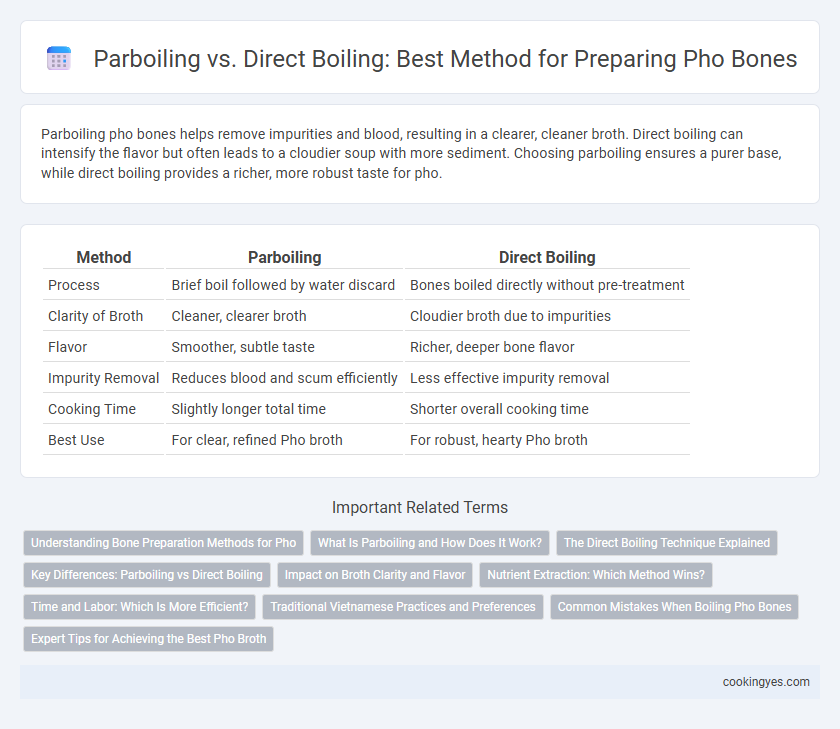Parboiling pho bones helps remove impurities and blood, resulting in a clearer, cleaner broth. Direct boiling can intensify the flavor but often leads to a cloudier soup with more sediment. Choosing parboiling ensures a purer base, while direct boiling provides a richer, more robust taste for pho.
Table of Comparison
| Method | Parboiling | Direct Boiling |
|---|---|---|
| Process | Brief boil followed by water discard | Bones boiled directly without pre-treatment |
| Clarity of Broth | Cleaner, clearer broth | Cloudier broth due to impurities |
| Flavor | Smoother, subtle taste | Richer, deeper bone flavor |
| Impurity Removal | Reduces blood and scum efficiently | Less effective impurity removal |
| Cooking Time | Slightly longer total time | Shorter overall cooking time |
| Best Use | For clear, refined Pho broth | For robust, hearty Pho broth |
Understanding Bone Preparation Methods for Pho
Parboiling pho bones involves simmering them briefly to remove impurities and blood, resulting in a clearer broth with a cleaner taste. Direct boiling skips this initial step, often producing a richer but cloudier broth due to the retained fats and proteins. Understanding these bone preparation methods is essential for controlling the flavor profile and clarity of authentic Vietnamese pho broth.
What Is Parboiling and How Does It Work?
Parboiling involves briefly boiling pho bones in water and then discarding the water to remove impurities, blood, and surface proteins that can cloud the broth. This process helps achieve a clearer, cleaner pho broth by eliminating unwanted flavors and scum before the bones are simmered for hours. Parboiled bones produce a refined, aromatic broth essential for authentic Vietnamese pho.
The Direct Boiling Technique Explained
Direct boiling of pho bones involves placing the bones directly into boiling water, which accelerates flavor extraction and results in a richer, more intense broth compared to parboiling. This technique allows marrow and collagen to infuse deeply into the soup, enhancing pho's signature savory taste and silky texture. Chefs often prefer direct boiling to achieve a robust umami profile essential for authentic Vietnamese pho.
Key Differences: Parboiling vs Direct Boiling
Parboiling pho bones involves briefly boiling them to remove impurities and blood, resulting in a clearer, cleaner broth essential for authentic pho flavor. Direct boiling skips this step, which can lead to a cloudier broth with stronger, sometimes overpowering meat flavors. The key difference lies in broth clarity and taste balance: parboiling enhances clarity and subtlety, while direct boiling accelerates flavor extraction but sacrifices broth purity.
Impact on Broth Clarity and Flavor
Parboiling pho bones removes impurities and excess fat, resulting in a clearer broth that highlights the delicate umami flavors. Direct boiling retains more marrow and collagen, producing a richer, more intensely flavored broth but with a cloudier appearance. Choosing parboiling or direct boiling impacts the balance between broth clarity and depth of flavor in traditional pho.
Nutrient Extraction: Which Method Wins?
Parboiling pho bones partially cooks them, reducing impurities and resulting in a clearer broth but causes some nutrient loss, particularly water-soluble minerals and collagen. Direct boiling maximizes nutrient extraction by breaking down bones and connective tissue more thoroughly, enriching the broth with gelatin, calcium, and amino acids essential for authentic pho flavor and health benefits. For optimal nutrient retention and depth of flavor, direct boiling ensures a richer, more nutritious pho broth compared to parboiling.
Time and Labor: Which Is More Efficient?
Parboiling pho bones requires a shorter initial cooking time, usually around 10-15 minutes, reducing impurities and resulting in a clearer broth with less skimming needed during the longer simmering phase. Direct boiling demands more active labor because of frequent foam and scum removal, while parboiling streamlines the process by minimizing these impurities early on. Overall, parboiling is more time-efficient and labor-saving, optimizing broth clarity and reducing daily maintenance during pho preparation.
Traditional Vietnamese Practices and Preferences
Traditional Vietnamese pho preparation favors parboiling bones to remove impurities and achieve a clearer broth, enhancing the soup's delicate flavor profile. Parboiling involves briefly boiling bones, then rinsing them before simmering, which contrasts with direct boiling where bones cook continuously without this initial step. This practice preserves the authentic taste and clarity prized in Vietnamese pho, distinguishing it from other broth-making methods.
Common Mistakes When Boiling Pho Bones
Parboiling pho bones helps remove impurities and results in a clearer broth, but over-parboiling can strip away essential flavors, leading to a bland soup. Direct boiling without an initial rinse often causes cloudy broth and off-putting scum that is difficult to skim, negatively affecting the pho's taste and appearance. Many beginners mistakenly boil the bones vigorously from the start instead of simmering gently, which emulsifies fats and results in a greasy, murky broth.
Expert Tips for Achieving the Best Pho Broth
Parboiling pho bones helps remove impurities and results in a clearer, cleaner broth preferred by traditionalists, while direct boiling extracts deeper umami flavors but may produce a cloudier soup. Experts recommend parboiling for 5-10 minutes, then rinsing the bones before simmering gently for at least 6 hours to balance clarity and richness. Maintaining a low simmer and skimming scum throughout the cooking process ensures an optimal, aromatic pho broth with layered complexity.
Parboiling vs Direct Boiling for Pho Bones Infographic

 cookingyes.com
cookingyes.com